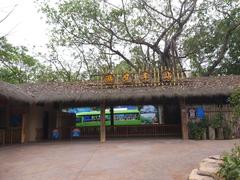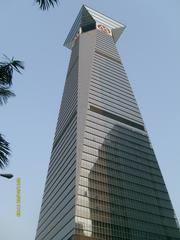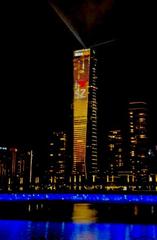
Shenzhen Safari Park: Complete Visiting Guide, History, Tickets, and Travel Tips
Date: 15/06/2025
Introduction
Shenzhen Safari Park (深圳野生动物园) is a premier wildlife destination and one of China’s most innovative open-range zoos, blending conservation, ecological education, and family-friendly entertainment. Established in 1993 as the nation’s first free-range wildlife park, it remains a pioneering force in animal welfare and immersive visitor experience. Spanning 1.2 square kilometers in Shenzhen’s Nanshan District, the park is a sanctuary for more than 10,000 animals representing over 300 species, including some of the world’s rarest and most endangered creatures such as the giant panda, South China tiger, and golden snub-nosed monkey (chinawiki.net).
This comprehensive guide covers everything you need to know for an enjoyable visit: Shenzhen Safari Park visiting hours, ticket options, park layout, accessibility, conservation initiatives, educational programs, nearby attractions, and practical travel tips. Whether you’re a wildlife enthusiast, a family seeking adventure, or a traveler exploring Shenzhen’s vibrant culture and history, Shenzhen Safari Park offers a memorable and enriching escape into nature (chinaexpeditiontours.com).
Table of Contents
- History and Significance
- Park Layout and Main Attractions
- Visitor Information
- Facilities and Amenities
- Conservation Initiatives
- Educational Value and Public Engagement
- Controversies and Challenges
- Practical Travel Tips and Nearby Attractions
- Frequently Asked Questions (FAQ)
- Visual & Media Resources
- Conclusion and Call to Action
- Official Sources
History and Significance
Founding and Development
Shenzhen Safari Park opened in 1993 as China’s first uncaged, free-range wildlife park, marking a shift from traditional caged exhibits to naturalistic, open habitats. Developed with a 250 million yuan investment, it is strategically situated near Xili Lake and Shenzhen University Town, forming a critical “green pearl” within the rapidly modernizing city (chinawiki.net).
Initially state-owned, the park transitioned to a joint-stock company in 2007 to improve efficiency and reflect broader economic reforms. Its establishment set a benchmark for modern zoo design in China (chinawiki.net).
Milestones and Recognition
- 1995: Named “Best in China” by the State Council Market Economy Research Institute.
- 2004/2008: Awarded “Shenzhen Civilization Demonstration Unit” and “Shenzhen Green Scenic Spot.”
- 2009: Launch of Ocean World.
- 2010: World’s first 5D zoo cinema opened.
- 2013: Arrival of a giant panda, further boosting its appeal (chinawiki.net).
Park Layout and Main Attractions
The park spans approximately 1.2 million square meters and is organized into thematic zones that mimic natural ecosystems:
1. Herbivore Zone
- Home to giraffes, zebras, Asian elephants, sika deer, kangaroos, camels, and more.
- Swan Lake, the largest in China, offers scenic boat rides among black and white swans (EastChinaTrip).
- Supervised feeding stations allow safe animal interactions, especially popular with families (ChinaTravel.com).
2. Predator (Beast Valley) Zone
- Safari-style bus tours traverse large, open enclosures housing lions, tigers (including white Bengal and Siberian varieties), ligers, tiglons, wolves, and bears.
- Unique feeding experiences let visitors offer meat to the big cats from protected vehicles (EastChinaTrip).
3. Walking and Performance Zones
- Walking areas feature primate islands, aviaries, reptile houses, and accessible gardens.
- Performance halls host daily animal shows: sea lions, birds, tigers, elephants, and a circus.
- The grand animal parade features over 1,000 animals and 300 performers (ChinaTravel.com).
4. Aquarium and Marine Life Section
- Ocean World features marine mammals, lemon sharks, dolphins, and educational exhibits on aquatic ecosystems (skyticket.com).
Visitor Information
Visiting Hours
- Regular Hours: 9:00 AM – 6:00 PM daily (last entry at 5:00 PM)
- Peak Periods: Hours may extend during holidays—check official announcements.
Ticket Prices
- Adults: ~CNY 150
- Children & Seniors: Discounts available; children under 1.2m enter free
- Special Attractions: Ocean World/Marine Pavilion requires an additional ticket (ChinaTravel.com)
- Where to Buy: Online (recommended for convenience), or at park entrance (Trip.com)
Getting There
- Metro: Line 7 to Xili Lake Station (Exit D), then short taxi/bus ride.
- Bus: Several public buses stop near the main entrance.
- Car: Onsite parking available (DeepChinaTravel).
Accessibility
- Wheelchair and stroller rentals available at the entrance.
- Paved paths, ramps, and shuttle buses provide easy access throughout the park.
Facilities and Amenities
- Rest Areas & Picnic Spots: Shaded benches and tables throughout the park.
- Food Outlets: A variety of restaurants and snack stands, including vegetarian and kid-friendly options.
- Restrooms: Modern, clean facilities at major zones.
- Souvenir Shops: Animal-themed merchandise and educational materials.
- First Aid Stations: Staffed for emergencies at key locations.
Conservation Initiatives
Species Protection and Breeding
- Over 10,000 animals from 300+ species, focusing on endangered species such as the South China tiger, golden snub-nosed monkey, and giant panda.
- Advanced breeding programs for rare animals and genetic research, including work with hybrids (ligers/tiglons), though these practices are debated (Tripways).
Habitat Simulation
- Open-range enclosures and specialized habitats for primates, pandas, and marine species mimic natural environments, promoting animal welfare (EastChinaTrip).
Marine and Aquatic Conservation
- Ocean World educates the public on marine ecosystems, though use of marine mammals in performances is controversial (Tripways).
Educational Value and Public Engagement
- Zoological Center: China’s largest, with interactive exhibits and animal specimens.
- School Partnerships: Workshops, field trips, and educational events for local students.
- Public Programs: Guided tours, animal feeding, behind-the-scenes experiences, and nature walks.
- Research: The park collaborates on animal behavior and conservation studies, sharing findings nationally and internationally (Wikipedia).
Controversies and Challenges
- Animal Performances: Shows featuring tigers, elephants, sea lions, and birds raise welfare concerns about training and animal stress (TravelChinaGuide).
- Hybrid Breeding: Creation of ligers/tiglons attracts visitors but is ethically debated.
- Conservation vs. Entertainment: Balancing educational goals with commercial attractions is an ongoing challenge.
- Environmental Management: High visitor numbers require effective crowd and waste management; shuttle services and designated paths help minimize impact (EastChinaTrip).
- Transparency: Calls for greater public reporting on animal welfare and adherence to international zoo standards.
Practical Travel Tips and Nearby Attractions
- Best Times: Weekdays, early mornings, and spring/autumn provide a comfortable and less crowded experience.
- Bring: Comfortable shoes, sun protection, a camera, and water.
- Nearby Sights:
- Window of the World: Miniature global landmarks.
- Splendid China Folk Village: Cultural exhibits.
- Dapeng Fortress & Shenzhen Museum: For cultural and historical exploration.
Frequently Asked Questions (FAQ)
Q: What are Shenzhen Safari Park’s visiting hours?
A: 9:00 AM–6:00 PM daily (last entry 5:00 PM).
Q: How much are tickets?
A: Adults ~CNY 150; discounts for children/seniors; free for children under 1.2m. Buy online or onsite (Trip.com).
Q: Is the park wheelchair accessible?
A: Yes, with paved paths, ramps, and rental services.
Q: Are guided tours available?
A: Yes, bookable on site or online.
Q: Can I bring my own snacks?
A: Yes, outside snacks are permitted.
Q: Are there educational programs?
A: Many, including animal feeding, workshops, and interactive exhibits.
Q: What is the best way to avoid crowds?
A: Visit on weekdays and early mornings.
Visual & Media Resources
Explore official park galleries and virtual tours for detailed maps and wildlife imagery. Use descriptive alt tags (e.g., “Shenzhen Safari Park Giant Panda Habitat”) for accessibility and SEO. Visitor maps and show schedules are also available at the entrance and online (ThemeParkBrochures).
Conclusion and Call to Action
Shenzhen Safari Park is a model of modern conservation and immersive wildlife tourism, offering visitors a rare chance to see endangered species in expansive, naturalistic settings. Its blend of adventure, education, and family fun makes it a must-visit for anyone in southern China.
Plan your visit today:
- Purchase tickets online for convenience.
- Arrive early for the best animal activity and to avoid crowds.
- Download the Audiala app for real-time updates, interactive maps, and exclusive offers.
Share your experiences using #ShenzhenSafariPark and follow us for the latest tips, events, and travel inspiration!
Official Sources
- Shenzhen Safari Park Overview, Chinawiki
- Shenzhen Safari Park Attractions, China Expedition Tours
- Shenzhen Safari Park Guide, Skyticket
- Shenzhen Safari Park Visitor Information, ChinaTravel.com
- Shenzhen Safari Park Ticket Booking, Trip.com
- Shenzhen Safari Park Conservation and Visitor Info, Tripways
- Shenzhen Safari Park Travel Tips, EastChinaTrip
- Shenzhen Safari Park Review and Visitor Tips, DeepChinaTravel
- Shenzhen Safari Park Performances and Welfare, TravelChinaGuide
- Shenzhen Safari Park Wikipedia Entry

















